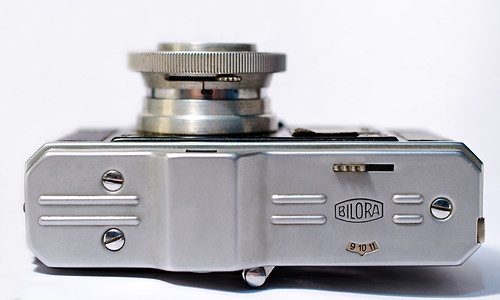Bilora Radix
| ||
|
Following on from their traditional inexpensive box cameras, beginning in 1948 Bilora created a series of charming and quirky little cameras which use 35mm film loaded in the special Karat cassettes introduced by Agfa in the 1930s. Unlike the Agfa models, these cameras' image format is 24mm square, yielding 16 shots per cassette.
Collectors may make distinctions between the model variants (see list below) but all share a sturdy and unexpectedly heavy chassis, and a unique shutter release tab that slides laterally. All are threaded at one end of the body for a cable release, and all but the earliest include a PC terminal for flash sync at the other. The back can be released by rotating a circular disk using its silver nubs, after which it pulls free completely (and can reattach oriented either way).
Only the initial model has the name "Bilora" and "f = 4cm" on its lens trim ring. Later models were sold as either "56" (with an f/5.6 lens) or "35" (f/3.5). The 56 version has bold line arcs on its trim ring, and the aperture is read through a minuscule circular hole. The 35 models are easily distinguished as their entire aperture scale and pointer tab are exposed.
Most examples have a simple time/instant shutter (controlled by a tab under the lens) variously said to be 1/50 to 1/60th of a second. With a minimum f/16 lens opening, this may cause difficulties when using modern fast film outdoors. The models designated "H" have a dial for five shutter speeds plus B on the front of the camera, giving the camera a very distinctive look (like a tiny bank safe).
Models with Bilora's "Biloxar anastigmat" branded lenses (designated "B") were less expensive than ones offering a name-brand Schneider Radionar (designated "S")—although the Biloxar does not seem to be inferior. All variants focus by twisting the entire front of the lens (aperture mechanism and all) although scale focus distance indicators (in meters) are sparse or absent.
Because the Karat format fed film from cassette to cassette, there is no rewind mechanism. Furthermore, the frame counter does not reset, it simply cycles from "16" through several blank frames, to "A" as the position for loading a fresh film cassette, and on to "1."
The viability of this camera series was prematurely curtailed, as even Agfa began moving away from the Karat format (the Karat 36 used Kodak's more successful 135 cartridge format). The 1960s revival of the Rapid cassette (even luring some Japanese camera-makers on board) came too late for the Radix, although those are the film cassettes which a modern user will likely turn to for reloading purposes.
Model list
- Radix 1 - The Ur-Radix
- Radix 2 - The second series
- Radix 2a - (Radix 56)
- Radix 2b - (Radix 56 Ennar)
- Radic 2c - (Radix 56 with flash contact)

|
| Radix 56 BH showing shutter scale and distinctive lens ring image by Philip Krayna (Image rights) |
- Radix 3a - (Radix 56 "B")
- Radix 3b - (Radix 56 "S")
- Radix 3c - (Radix 35 "B")
- Radix 3e - (Radix 35 "S")
- Radix 4 - (Radix 56 "A")
- Radix 5a - (Radix 35 BH)
- Radix 5b - (Radix 35 SH)
- Radix 6 - (Radix 56 BH)
Links
In English
In Danish
In German

